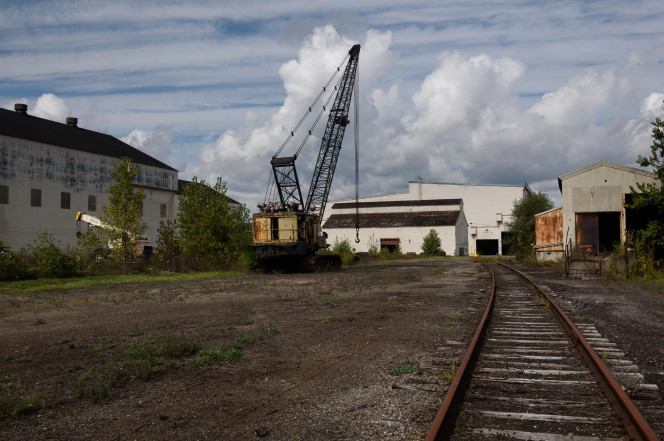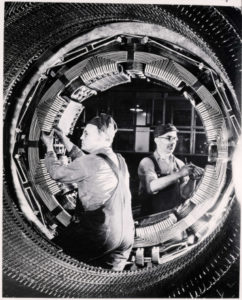The New York Post: The day that destroyed the working class and sowed the seeds of Trump

Rusty remains and railroad tracks sit quiet at the Casey Industrial Park, once the Campbell Works of Youngstown Steel and Tube in Struthers, Ohio. Justin Merriman for The New York Post
By Salena Zito | September 16, 2017
CAMPBELL, Ohio — Forty years ago, on Sept. 19, thousands of men walked into the Campbell Works of Youngstown Sheet and Tube along the Mahoning River before the early shift.
Like every fall morning, they were armed with lunch pails and hard hats; the only worry on their minds was the upcoming Pittsburgh Steelers game on “Monday Night Football.” The only arguing you heard was whether quarterback Terry Bradshaw had fully recovered from the dramatic hit he took from a Cleveland Browns player the season before.
It was just before 7 a.m., and the fog that had settled over the river was beginning to lift. As the sun began to streak through the mist, the men made their way into the labyrinth of buildings where they worked.
In the next hour, their lives would change forever.
From then on, this date in 1977 would be known as Black Monday in the Steel Valley, which stretches from Mahoning and Trumbull counties in Ohio eastward toward Pittsburgh. It is the date when Youngstown Sheet and Tube abruptly furloughed 5,000 workers in one day.
The bleeding never stopped.
Within the next 18 months, US Steel announced that the nation’s largest steel producer was also shutting down 16 plants across the nation, including their Ohio Works in Youngstown, a move that eliminated an additional 4,000 workers here. That announcement came one day before Jones and Laughlin Steel Corp. said they were cutting thousands of jobs at their facilities in the Mahoning Valley, too.
Within a decade, 40,000 jobs were gone. Within that same decade, 50,000 people had left the region, and by the next decade, that number was up to 100,000. Today the 22 miles of booming steel mills and the support industries that once lined the Mahoning River have mostly disappeared — either blown up, dismantled or reclaimed by nature.
If a bomb had hit this region, the scar would be no less severe on its landscape.
“The domino effect of Black Monday went on forever,” said Gary Steinbeck of nearby Warren, Ohio. Steinbeck was working up the river that day from the rolling plant at H.K. Porter, which also later went out of business. “The word spread quickly. Back then there weren’t any cellphones or social media. Good news travels fast, bad news travels at the speed of light. We knew within the hour the guys down the river were hurting, we knew within a day families were hurting, we knew within a week the whole region was suffering,” he said.
“Those numbers only reflect the jobs that were lost in the plant; the ripple effect was equally devastating. Grocery stores, pizza shops, gas stations, restaurants, department stores, car dealerships, barber shops all saw their business plummet and they started closing,” said Steinbeck.

Labor activist Staughton Lynd (left) led a drive in the 1970s after steel factory closings to pressure DC to stop imports. Gary Steinbeck (right) is a former steelworker.Justin Merriman for The New York Post
Steinbeck was only 25 on Black Monday — but he said he knew then that the blow to his hometown would not be felt the same way in Washington.
News reports from the days and weeks following Black Monday showed that the White House, larger business community and economic experts were detached from the potency of what was happening here. They thought the overall economic impact was exaggerated, that it would not be the calamity Steinbeck and everyone else in Youngstown knew it would be.
“No one never calculated the cultural tragedy as part of the equation either,” Steinbeck said. “They didn’t just dismantle the old mills, they dismantled the societal fabric of what made Youngstown Youngstown.”
The Manhattan radical
At first the Mahoning Valley did not give up hope, none of them did. In fact they did something remarkable: The entire community fought back by forming a local initiative that consisted of faith leaders, local politicians and even a couple of radical activists, most notably Staughton Lynd, a formidable figure in the ’60s social justice movement.
“The response in this community took the country and the community members themselves by surprise,” said Lynd from his basement in his Niles, Ohio, home in Trumbull County.
On the night of Black Monday, Lynd remembers an emergency meeting was called by the Central Labor Union and a plan was endorsed to send petitions to President Jimmy Carter encouraging him to stop steel imports and put an ease on regulations that were hurting the industry. At the time, newer plants in China and Japan, which had better technological capabilities, were outstripping American production.
“By Friday over 100,000 signatures had been collected and chartered buses went to Washington to deliver them to the president,” said Lynd.
Three hundred men, local elected officials and faith leaders all traveled on five buses to the White House. The mood on the drive was somber, and the late Sen. John Glenn stood on the US Capitol steps, along with other elected officials, as the men waved signs that read “Save the Steel Industry.”
Carter never even bothered to send out an aide to receive the petitions when they arrived. Amazingly, the president, who was a well-known supporter of the working class, never even acknowledged them.
Lynd is flanked by hundreds of labor movement and anti-war buttons on the wall behind him. At 87 he is trim, soft-spoken and humble. As if in reflection of his Quaker upbringing, his home is modest, and so is he. He really doesn’t look the part of a ’60s radical.
